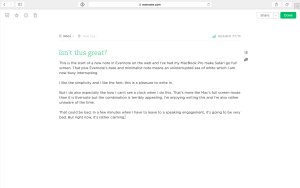Or at least to work better for and with you. They’ve got a lot on their plate, they know you’re good, it is easy for them to lob more work at you and just assume you’ll do it. After all, you have done every time so far and it’s only cost you an ulcer.
Your employer always keeps a certain distance and it’s always for one good reason, sometimes also for one bad one. The bad is that they’re eejits and up themselves but that type doesn’t last. They last longer than you’d want, but. The good reason is that they will only show you the bits of their job that you need to do yours: they won’t lumber you with the rest of the stuff they’ve got to do, they maybe can’t tell you the rest of the stuff.
(Quick aside? A friend was my manager once at the BBC and she was having a rough time over a particular problem. We chatted like pals and it turned out that she was going to have to let some people go. Yes. I could see the moment those cogs turned and those synapses worked and she remembered that I was highly likely to be one of them. Her face was so funny, I laughed.
On the one hand, it was good and flattering that she could open up to me but on the other, you know she felt bad when she realised. That’s a difficult line to tread when you work for someone you know and like, but it needs to be trod. Especially since I didn’t lose my work then and in fact nobody did. From my point of view, I had some weeks of worry and from hers I was surely distracted and losing time looking for other work, all ultimately for nothing because something outside both our control changed.)
Anyway.
Train your bosses to better understand what you do and what you can do. On Monday morning, email them with a happy note about what five things you’re going to do this week. They probably already know them and it’s certain that something other than those five will come up but email them the list of five on Monday morning. And then on Friday afternoon, email them to say you’ve done those five.
That’s all. It will take ages for this to become a habit for you and for them, but you’re setting out your work for the week and then you are demonstrating that you do it. Without ever suggesting that this is all you’ll do, you’re firstly informing them that they don’t have to think of things for you to do and you’re secondly reinforcing 52 times a year that you do what you say you’ll do.
Your bosses do dump work on you but they also look for things for you to do: they want you happy in the workplace but they want you busy too. You’re an expensive resource and they need to use you fully. With this five-item email, most of the time they will recognise that you’re on the job, you’re on the case, they don’t have to worry about you. And sometimes it will stop them lumbering you with other things. Sometimes.
So it does help them and it does help you in your annual review. But I’m also slightly lying to you.
I don’t care if your bosses ever read your email to them, I only care that you write and send it. Because writing that list of five clarifies your week in your mind and that means you never have to think about it again. Yes, things come up, things change, but for the rest of the week you will not be forever wondering which thing is most urgent to do next.
Sending the list to them adds accountability, again even if they never read it. You’ve said this aloud, that’s what you’ve done.
Then, to be completely honest here, having said aloud that you’re going to do these five things, you will do them. And when you write that Friday afternoon email saying that you have, you will feel great.
And do you know why? Because you are.
